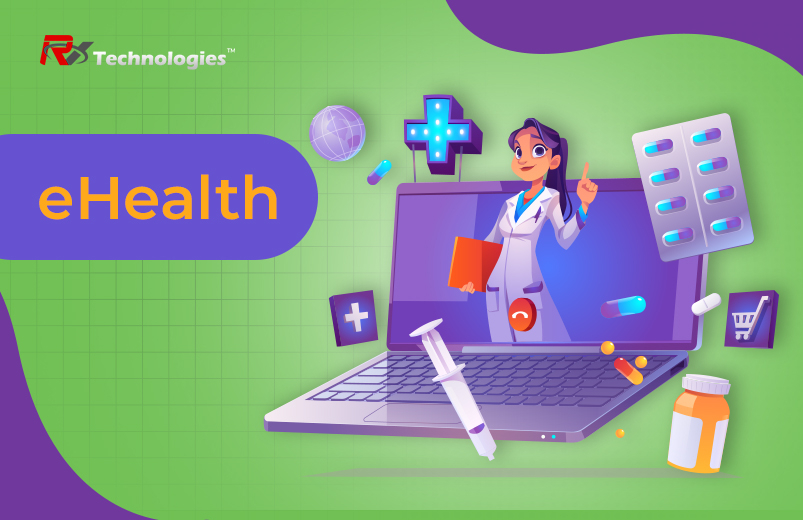In a world of increasing digitalization, patients are now becoming knowledgeable about their medical conditions and treatment options. They are more likely to voice their concerns and prefer personalized solutions that suit their lifestyle and needs. It is no longer just ‘doctor vs patient’ but a collaborative effort to help patients live a healthy life.
Moreover, healthcare app development companies are doing wonders in terms of bringing mobile-friendly solutions to solve patients’ issues such as Pocket Pharmacist, Teladoc, Medisafe Pill Minder, and more.
Thus, the collaboration between various stakeholders and technology adoption has made it possible for healthcare to become more accessible, affordable, and convenient for users.
Read on to learn about the 10 challenges that eHealth solutions can resolve because of the advancement in technology.
eHealth Apps – Worldwide Statistics
Over the past two decades, hospitals and health systems have incorporated digital technologies into their operational areas. The COVID-19 pandemic substantially disrupted the status quo in the healthcare sector, making virtual health and home care not only necessary but also desirable.
As per Statista, the revenue in the eHealth Apps is projected to reach US$1.55bn in 2022 and will grow at a CAGR of 14.18% with a market volume of US$3.00bn by 2027. Thus, it is the best time to hire a healthcare app development company with your healthcare solution that can solve your target audience problems.
What is eHealth?
Using information and communication technologies to support health and healthcare is known as e-Health. Telemedicine, smartphone apps, and wearable sensors are three of the most anticipated sectors to see upheaval. And citizens are increasingly using these digital tools to assist in making decisions about their own health and medical care.
Top 10 challenges that eHealth solution can resolve
The use of information and technologies to improve healthcare is called eHealth and implementing such technology can help you remain on top of things and become one of the most technologically advanced healthcare providers.
In an effort to create a better and healthier world, we’ve attempted to highlight some of the most prevalent issues that the new, cutting-edge healthcare system can address utilising technology:
-
Healthcare Data Management and Security
The healthcare industry has long been plagued by issues concerning data security and privacy. With the increase in data availability and sharing, patients are more concerned about the safety and ownership of their data. This is especially relevant for sensitive data such as patient health records, their genetic information, and their personal data.
When it comes to patient data management, an eHealth solution can help healthcare providers store and manage their patient health data properly. It can also help them provide patients with secure access to their medical information from wherever they are. For example, patients can now request for an electronic health certification (eHealth certification) for government-related certifications like visa applications.
And the up-and-coming solution to the data sharing issue will be a blockchain-based database to store and share patient records.
-
Healthcare Mobile And Web Application

There was a time when healthcare was limited to only in-person consultations. And at the time of deadly coronavirus it became the need of an hour.
But, mobile app developers with their healthcare app development services made it possible for doctors to offer patients who are located far away competent treatment and guidance.
Telemedicine strives to improve healthcare by using wearables and smartphones to track health using mobile healthcare solutions. The creation of goods that experiment with technology like holography, artificial intelligence, machine learning, augmented reality, and virtual reality has been spurred by the use of technology in healthcare.
-
Storing and Managing Patient Data
With the use of a centralized eHealth platform, healthcare providers can enable patients to view, edit, and share their medical data with doctors and family members. Patients can also store their prescriptions, allergies, and other relevant health information on the platform.
The eHealth solution can also be leveraged to help healthcare providers and staff schedule appointments, manage their shift duties, and provide patients with a single-window view of their medical history, record, and test results by using cloud-based data systems and mobile portals.
These solutions allow healthcare professionals to access the data in real-time like medical history , registrations, appointments, diagnoses, treatments, and more.
Thus, healthcare app development and integration of systems with apps as per on iOS, and Android platforms provide flexibility to doctors and other practitioners.
-
Better Collaboration between Healthcare Providers
The shift towards a more collaborative healthcare model has created new challenges in communication and coordination between healthcare providers. For example, when a patient requires multiple specialists, caregivers, and medical resources, there must be a clear communication channel to facilitate the transitions between them.
An eHealth solution with integrated workflow and communication features can help solve this challenge. When it comes to the exchange of information and data, an eHealth platform ensures that information is securely and seamlessly shared between various stakeholders such as patients, doctors, and medical specialists.
-
Advancement in Remote Patient Monitoring
The shift towards digitization has led to a rapid development in remote patient monitoring features. This is especially relevant for patients who are unable to visit a clinic or doctor due to time or location constraints.
A remote patient monitoring solution can help these patients by providing them with the option to select their preferred method of monitoring (e.g. regular phone calls, online chat, SMS, etc.) and report their current health condition.
Remote patient monitoring can also help patients adhere to their treatment plan more accurately by enabling them to report on the timings of their medicines and supplement intake, meal timings, and sleep patterns.
When it comes to monitoring the remote health of infants, a remote patient monitoring solution can help parents track their baby’s regular feed and sleep timings, daily development progress, and health progress. It can also help parents monitor the baby’s health conditions and send an alert in the event of a sudden change in the baby’s health.
For example the Internet of Medical Things (a collection of medical devices and applications and devices) uses Wi-Fi to enable the machine-to-machine communication with cloud platforms, say Amazon Web Services, where data is stored and analyzed.
-
Advancement in AI and Robotics in Healthcare

There were times when healthcare professionals in some cases were not able to make correct diagnoses. Artificial intelligence is being leveraged in the healthcare industry to help physicians make accurate diagnoses, recommend treatment plans, and prescribe personalized medication. AI is also being used in healthcare to help patients understand their diagnosis and treatment plan more clearly.
Similarly, robotics are being used in healthcare to help patients adhere to their treatment plan and manage their pain more effectively. Robotics can also be used in surgery to improve the accuracy of the surgeon, reduce surgical complications, and provide patients with faster surgical healing times.
-
Advancement in Augmented Reality in Healthcare
Gone are the days when there was no technology to do a surgery. And now the healthcare industry is witnessing a rise in the adoption of Augmented Reality (AR) in the treatment of various medical conditions. This is especially relevant for minor surgeries, orthopedic surgeries, and in the treatment of children with autism. When it comes to the treatment of children with autism, an AR solution can help parents track their child’s emotional development, behavioral patterns, and social interactions.
It can also help parents provide their child with visual cues to help them understand social interactions and daily tasks. When it comes to the treatment of minor surgeries, an AR solution can help physicians visualize their incision site and help patients visualize their post-surgery progress. It can also help patients visualize their treatment plan and learn how to perform exercises or other self-help treatments.
-
mHealth Mobile Apps
The offline healthcare systems are unsustainable, and many individuals cannot afford routine check-ups and primary healthcare.
Considering that people need constant access to healthcare services, mHealth apps are becoming more popular. Thus by hiring a healthcare app development company and developing such apps, healthcare services have become so accessible that anyone with a credit card can immediately pay for an urgent consultation. They can see doctors outside of their state because the distance barrier is minimal.
The demands on the healthcare system will increase as the population ages. By 2032, a physician shortage is expected, however technology like mHealth will help to lessen the effects.
-
Advancement in Biometric Identification Technology
Biometric identification technology is the process of identifying individuals based on their biological or behavioral characteristics. When it comes to the healthcare industry, biometric technology is being used to help physicians and caregivers identify patients accurately, track patient progress closely, and provide patients with customized care plans.
Biometric identification can also be used to help patients track their health progress closely and manage their health conditions more effectively.
When it comes to eHealth, biometric identification can be leveraged to allow patients to sign in to their eHealth account and view their medical history from anywhere. It can also be used to allow patients to securely access their treatment plans and other health-related information on the eHealth platform with ease.
-
Integrating Big-Style Data With Medical Imaging
About 600 million imaging treatments are carried out annually in the US, which emphasises the importance of medical imaging. The time and money required to manually analyse and preserve these photos is high because radiologists must look at each image separately and hospitals must keep them for a number of years.
Medical imaging provider Carestream explains how big data analytics for healthcare could alter how photos are viewed since algorithms created after studying hundreds of thousands of images could recognise specific patterns in the pixels and translate them into numbers to aid doctors in diagnosing patients.
They even go a step further and speculate that radiologists may no longer need to view the images themselves in favour of analysing the results of the algorithms, which will unavoidably study and retain many more images than they could ever possibly remember in their lifetimes. This would likely have an impact on the job duties, educational requirements, and skill set needed for radiologists.
Conclusion
The healthcare industry has long been plagued by issues concerning data security and privacy. With the increase in data availability and sharing, patients are more concerned about the safety and ownership of their data.
This is especially relevant for sensitive data such as patient health records, their genetic information, and their personal data. When it comes to healthcare data management, an eHealth solution can help healthcare providers store and manage their patient health data properly.
When it comes to the treatment of minor surgeries, an AR solution can help physicians visualize their incision site and help patients visualize their post-surgery progress. Biometric identification technology can be leveraged to allow patients to sign in to their eHealth account and track their progress closely.





 Updated: November 17, 2022
Updated: November 17, 2022 






